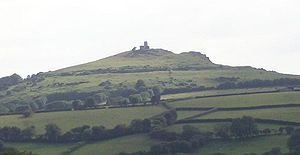
Brent Tor
Encyclopedia

Brent Tor is a tor on the western edge of Dartmoor
Dartmoor
Dartmoor is an area of moorland in south Devon, England. Protected by National Park status, it covers .The granite upland dates from the Carboniferous period of geological history. The moorland is capped with many exposed granite hilltops known as tors, providing habitats for Dartmoor wildlife. The...
, approximately five miles (8 km) north of Tavistock, rising to 1100ft (330m) above sea level. The Tor is surmounted by the Church of St Michael, the parish church of the village of Brentor
Brentor
Brentor is a village in West Devon, England. Its population in 2001 was 423. The village is dominated by the hill of Brent Tor, topped by the village's church....
, which lies below the Tor.
Geology
Brent Tor is a unique example of an early CarboniferousCarboniferous
The Carboniferous is a geologic period and system that extends from the end of the Devonian Period, about 359.2 ± 2.5 Mya , to the beginning of the Permian Period, about 299.0 ± 0.8 Mya . The name is derived from the Latin word for coal, carbo. Carboniferous means "coal-bearing"...
basaltic volcano
Volcano
2. Bedrock3. Conduit 4. Base5. Sill6. Dike7. Layers of ash emitted by the volcano8. Flank| 9. Layers of lava emitted by the volcano10. Throat11. Parasitic cone12. Lava flow13. Vent14. Crater15...
, now weathered down. It is composed of volcanic breccia
Breccia
Breccia is a rock composed of broken fragments of minerals or rock cemented together by a fine-grained matrix, that can be either similar to or different from the composition of the fragments....
and pillow lava
Pillow lava
Pillow lavas are lavas that contain characteristic pillow-shaped structures that are attributed to the extrusion of the lava under water, or subaqueous extrusion. Pillow lavas in volcanic rock are characterized by thick sequences of discontinuous pillow-shaped masses, commonly up to one metre in...
exuded beneath a former sea.
History
Around the Tor are (apparently) Iron AgeIron Age
The Iron Age is the archaeological period generally occurring after the Bronze Age, marked by the prevalent use of iron. The early period of the age is characterized by the widespread use of iron or steel. The adoption of such material coincided with other changes in society, including differing...
earthworks, the remnants of a Hill fort
Hill fort
A hill fort is a type of earthworks used as a fortified refuge or defended settlement, located to exploit a rise in elevation for defensive advantage. They are typically European and of the Bronze and Iron Ages. Some were used in the post-Roman period...
. Unusually, the fortifications are at the base of the Tor, rather than the summit as is more normal (compare with Brent Knoll
Brent Knoll
Brent Knoll is a village in Somerset, England, which lies on the southern edge of Brent Knoll – a hill with a height of 137 metres that dominates the low surrounding landscape of the Somerset Levels.-History:...
in Somerset
Somerset
The ceremonial and non-metropolitan county of Somerset in South West England borders Bristol and Gloucestershire to the north, Wiltshire to the east, Dorset to the south-east, and Devon to the south-west. It is partly bounded to the north and west by the Bristol Channel and the estuary of the...
). No serious archaeological work has been carried out on the site. However, the northern ramparts in particular are well preserved, displaying a multi-vallate pattern characteristic of the Iron-A, or early -B, culture. There are three distinct consecutive ramparts in this sector, and traces of internal partitioning.
The Church of St Michel de Rupe ("Saint Michael of the Rock") atop the Tor dates to the 13th century, and measures 15 feet (4.6 m) wide and 37 feet (11.3 m) long. The tower is 40 feet (12.2 m) high and houses three bells. At one point, the Church may have been used as a Beacon
Beacon
A beacon is an intentionally conspicuous device designed to attract attention to a specific location.Beacons can also be combined with semaphoric or other indicators to provide important information, such as the status of an airport, by the colour and rotational pattern of its airport beacon, or of...
tower, used to spread word of enemies seen out to sea (see also Spanish Armada
Spanish Armada
This article refers to the Battle of Gravelines, for the modern navy of Spain, see Spanish NavyThe Spanish Armada was the Spanish fleet that sailed against England under the command of the Duke of Medina Sidonia in 1588, with the intention of overthrowing Elizabeth I of England to stop English...
).
The Church has a capacity of approximately forty people. Although there is a newer (19th century) church (Christchurch) in the village, which is used for many services, St Michael's is still used on Christmas Day, Easter Day and for Evensong during the summer. In 1995 the Church was struck by lightning, which caused extensive damage, but this has since been repaired.
Legends
There are many legends surrounding Brent Tor.One of the best-known is that of the Merchant and the Storm. According to this story, an early medieval merchant paid for the church to be completed after nearly being shipwrecked.
The churchyard was the scene of filming for the BBC tv version of Jamaica Inn
Jamaica Inn
The Jamaica Inn, originally a public house and now an inn, is a Grade II listed building in the civil parish of Altarnun, Cornwall, United Kingdom. Located near the middle of Bodmin Moor near the hamlet of Bolventor, it was built as a coaching house in 1750 as a staging post for changing horses...
.

